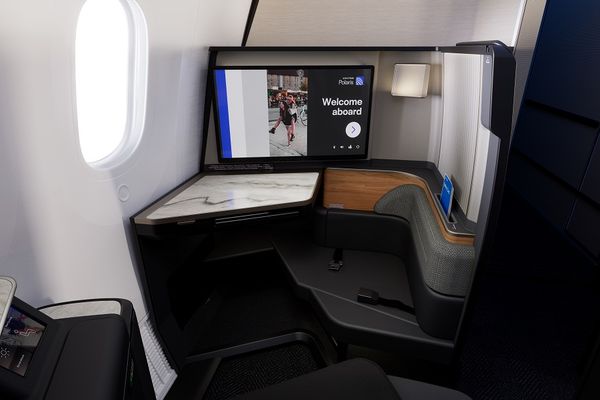French startup Lovenie is seeking to shake up the leisure flying and go-karting market with a brand new product for single flyers, a type of product Lovenie calls a "Kart".
Lovenie is building VTOL vehicles (Vertical Take-off and Landing) that act just like go-carts. In essence, the kart takes the shell of an F1 vehicle, contains no thermal engine and wheels, and adds an electric motor and propellers. Lovenie notes that this process is oversimplified, but you get the idea. The product is built for speed and fun in an enclosed environment — think K1 speed but in the sky.
This idea has no previous models to build from; Lovenie is the pioneer. Go-karting in the sky would be considered too futuristic to everyone except the people behind Lovenie, and the concept is almost here. Lovenie announced in a June 27 press release that tests on their first karts will commence later this summer, and commercialization will begin in the fall of next year.

Their initial business model calls for rentals: members of the public and aviation enthusiasts can rent a ride on the single-passenger craft for 15-minute intervals, in a leisurely or competitive manner.
Lovenie is currently building three different prototypes:
- A single-seater powered by 90kW of electricity. It contains eight motors and weighs 80 kg.
- A hybrid engine (90kW of electricity + 40 hp heat) single-seater weighing 130kg. The hybrid engine gives it 45 minutes of additional flying time.
- A two-seater version of their hybrid prototype.
The controlled environment is heavily regulated considering the number of risks involved. The karts are built such that they can never flip over, and can fly at a maximum height of 2 meters (6.5 feet) above the ground. Flyers will have radios to communicate with a control staff and have a built-in control system such that a control center has remote access to the steering should something go awry.

Lovenie plans to hold "rallies" with their karts where people race for the fastest time on a Lovenie-designed track. The startup writes on their website that they plan to create tracks in a closed and protected environment, most likely in the forest, plain areas, or even on the sea or a lake. There are also talks of using already-made race tracks and adapting them for racing in the sky. One notable benefit to this model is that infrastructure is mainly built up and the track will not wear down over time since no contact is made with the kart. Lovenie is calling these tracks "leisure centers".
For any fan of mechanical sports, cars, or even racing, Lovenie is a thrill. It is adrenaline-filled, environmentally friendly, novel, and leisurely all at the same time. Future plans call for even more vehicles that may not be restricted to enclosed environments, adding to the fun.
Jazeera Airways to Become First Commercial Carrier at Amman Marka Airport » 2025: Aviation Deaths are Down 27.3%, But Things Didn't Feel Safer » World’s Most On-Time Airlines and Airports of 2025 »
Comments (3)
 Bruce
I'm trying to imagine the sound from a dozen or so of those buzzing around.
Bruce
I'm trying to imagine the sound from a dozen or so of those buzzing around.
 Smitty Smithsonite
Would sound great I'd wager! Looks like a blast to pilot!
Smitty Smithsonite
Would sound great I'd wager! Looks like a blast to pilot!
 Eco_Turbo
Agreed!
Eco_Turbo
Agreed!
Add Your Comment
SHARE
TAGS
NEWS Flying Go-Kart Kart Future Drone F1 Racing LovenieRECENTLY PUBLISHED
 This Week in Aviation: The 10 Stories That Mattered Most
From major airline developments to aircraft updates and industry shifts, this weekly recap highlights the ten most-read aviation stories from the week of December 28.
INFORMATIONAL
READ MORE »
This Week in Aviation: The 10 Stories That Mattered Most
From major airline developments to aircraft updates and industry shifts, this weekly recap highlights the ten most-read aviation stories from the week of December 28.
INFORMATIONAL
READ MORE »
 Nearly 500 Flights Cancelled Following Venezuela Attack, Caribbean Airspace Closure
Hundreds of flights have been cancelled this morning after an overnight U.S. military attack in Venezuela left airspace in much of the Caribbean closed.
NEWS
READ MORE »
Nearly 500 Flights Cancelled Following Venezuela Attack, Caribbean Airspace Closure
Hundreds of flights have been cancelled this morning after an overnight U.S. military attack in Venezuela left airspace in much of the Caribbean closed.
NEWS
READ MORE »
 Why Airline Class Wars Will Intensify in 2026
The "Class War" of 2026 is no longer just about legroom; it is a calculated, multi-billion-dollar strategic pivot by Original Equipment Manufacturers (OEMs) and carriers to capture a "splurge-ready" traveller base that is increasingly opting for "one big trip" over frequent, low-cost hops.
INFORMATIONAL
READ MORE »
Why Airline Class Wars Will Intensify in 2026
The "Class War" of 2026 is no longer just about legroom; it is a calculated, multi-billion-dollar strategic pivot by Original Equipment Manufacturers (OEMs) and carriers to capture a "splurge-ready" traveller base that is increasingly opting for "one big trip" over frequent, low-cost hops.
INFORMATIONAL
READ MORE »


